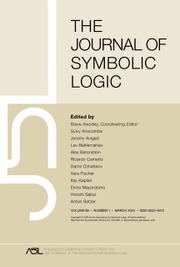Article contents
Automorphism groups of models of Peano arithmetic
Published online by Cambridge University Press: 12 March 2014
Extract
Which groups are isomorphic to automorphism groups of models of Peano Arithmetic? It will be shown here that any group that has half a chance of being isomorphic to the automorphism group of some model of Peano Arithmetic actually is.
For any structure  , let Aut(
, let Aut( ) be its automorphism group. There are groups which are not isomorphic to any model
) be its automorphism group. There are groups which are not isomorphic to any model  = (N, +, ·, 0, 1, ≤) of PA. For example, it is clear that Aut(N), being a subgroup of Aut((
= (N, +, ·, 0, 1, ≤) of PA. For example, it is clear that Aut(N), being a subgroup of Aut(( , <)), must be torsion-free. However, as will be proved in this paper, if (A, <) is a linearly ordered set and G is a subgroup of Aut((A, <)), then there are models
, <)), must be torsion-free. However, as will be proved in this paper, if (A, <) is a linearly ordered set and G is a subgroup of Aut((A, <)), then there are models  of PA such that Aut(
of PA such that Aut( ) ≅ G.
) ≅ G.
If  is a structure, then its automorphism group can be considered as a topological group by letting the stabilizers of finite subsets of A be the basic open subgroups. If
is a structure, then its automorphism group can be considered as a topological group by letting the stabilizers of finite subsets of A be the basic open subgroups. If  ′ is an expansion of
′ is an expansion of  , then Aut(
, then Aut( ′) is a closed subgroup of Aut(
′) is a closed subgroup of Aut( ). Conversely, for any closed subgroup G ≤ Aut(
). Conversely, for any closed subgroup G ≤ Aut( ) there is an expansion
) there is an expansion  ′ of
′ of  such that Aut(
such that Aut( ′) = G. Thus, if
′) = G. Thus, if  is a model of PA, then Aut(
is a model of PA, then Aut( ) is not only a subgroup of Aut((N, <)), but it is even a closed subgroup of Aut((N, ′)).
) is not only a subgroup of Aut((N, <)), but it is even a closed subgroup of Aut((N, ′)).
There is a characterization, due to Cohn [2] and to Conrad [3], of those groups G which are isomorphic to closed subgroups of automorphism groups of linearly ordered sets.
Information
- Type
- Research Article
- Information
- Copyright
- Copyright © Association for Symbolic Logic 2002
References
REFERENCES
- 6
- Cited by

